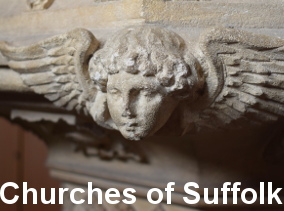
e-mail simon@suffolkchurches.co.uk
The Castle Chapel, Orford
Not many buildings can claim to be an
irregular tapering octadecagonal prism, but Orford Castle
can, according to my seven year old son who has been
doing shape in mathematics. It means that its
cross-section has 18 sides. The things they teach them in
school nowadays.
|
| The outer wall holds blank arcades,
and the vague outlines of aumbry, piscina and sedilia. In its long history, this chapel witnessed the
Catholic Mass for almost 400
years, and protestant prayerbook services for a century
or so afterwards. It is not used for liturgical purposes
today, and is not considered a consecrated space.
English Heritage Ritualistic. Note aumbry, piscina and sedilia. Orford Castle lies at the very end of the B1084 from Woodbridge. It is in the care of English Heritage, and you'll have to pay to get in. See MAP |